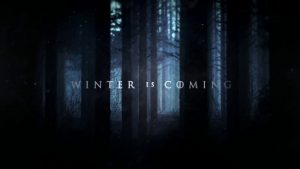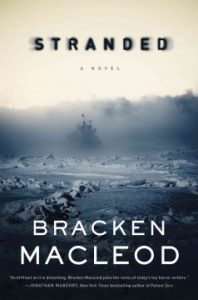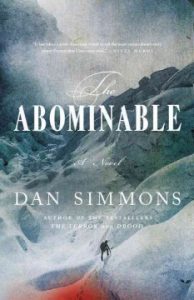
…Or, judging by the frost on my car this morning, dear readers, it might actually already be here.
I’ll be honest with you–I love winter. I love the cold, I adore snow. I was one of those kids who went tearing out of the house without a coat on and flung themselves at the nearest snowdrift (ok, I still do that, who am I kidding?). But I realize that I am most likely in the minority here.
As much fun as it can be to sit cozily inside and watch the snow fall, or to flaunt your new boots and scarves this time of year, the truth of it is that human bodies really really don’t like to be cold. It’s one of those primal fears built into all our brains, just like a fear of the dark, and a fear of being alone. All of these things aren’t modern-day constructions; they are primal triggers that have been passed down to us from our single-celled organism ancestors. Because all of them are, potentially, mortal dangers.
And this is what makes a genre that I am hereby terming Arctic Horror such a rip-roaring success. We could also call it ‘Polar Horror’ or ‘Cold Horror”, but what we’re discussing are books that are set in remote, usually the Arctic, sometimes on Antarctica or a really high mountain, where it’s really, really cold. And dark. And isolating. If done right, these books are not only fascinating journeys to places that most of us will never see–they are also absolutely terrifying, precisely because they tap into those brain-stem fears that we all have in common. Even while you rationally know you are safe and warm and connected to the outside world, the visceral feeling of experiencing these harrowing expeditions, these brutal quests, or these races against time are experiences that linger long after the final page has turned.
But horror novels are more than just the scary stuff. In order for the scary stuff to be scary, in order for us to feel for the characters who are enduring these hardships, we need to care about them. We need to see ourselves in them, and we need to want them to survive. So along with creating powerfully affecting settings, authors of Arctic horror also have to create genuinely real characters, and powerful relationships between them that ground us in their realities and make thier journeys that much more fraught.
So I thought I’d share some of the highlights of Arctic Horror that I’ve found recently, for those of you looking for a high-stakes, low-temperature thrill. They may help you pass the next long, winter night–or give you the itch to go out on an adventure of your own!
 Dark Matter: Although this book only lives at the Boston Public Library, it’s a piece of cake to get those books, either by getting your own BPL card (any resident of Massachusetts is eligible), or by having one of your friendly Reference Librarians put in an Inter-Library Loan request for you. Believe me, this little book is worth it. In it, we follow Jack, a penniless, desperate, but adventurous young man who, in January 1937, manages to get himself accepted on board an Arctic expedition as a radio operator. He and his small team weather the journey north, and prepare to make their winter home at a deserted bay known as Gruhuken. But as the nights grow longer Jack begins to realize that there is more to fear in Gruhuken than the plummeting temperatures. Members of his expedition team are being forced to leave, one by one, until Jack is the only man left–but he knows he isn’t alone. And he knows whatever is outside is watching him. Michelle Paver does a brilliant job creating Jack, and giving him both the wonder we would no doubt feel at his adventures, as well as the annoyance we would all feel at being stuck in cramped quarters with near-strangers for months on end. The terror here builds slowly, but with the strength of a blizzard. Once it hits, there is no turning back, and eventually reaches a climax that is disorienting, overwhelming, and genuinely frightening. (See the end of this post for a tiny, but helpful spoiler)
Dark Matter: Although this book only lives at the Boston Public Library, it’s a piece of cake to get those books, either by getting your own BPL card (any resident of Massachusetts is eligible), or by having one of your friendly Reference Librarians put in an Inter-Library Loan request for you. Believe me, this little book is worth it. In it, we follow Jack, a penniless, desperate, but adventurous young man who, in January 1937, manages to get himself accepted on board an Arctic expedition as a radio operator. He and his small team weather the journey north, and prepare to make their winter home at a deserted bay known as Gruhuken. But as the nights grow longer Jack begins to realize that there is more to fear in Gruhuken than the plummeting temperatures. Members of his expedition team are being forced to leave, one by one, until Jack is the only man left–but he knows he isn’t alone. And he knows whatever is outside is watching him. Michelle Paver does a brilliant job creating Jack, and giving him both the wonder we would no doubt feel at his adventures, as well as the annoyance we would all feel at being stuck in cramped quarters with near-strangers for months on end. The terror here builds slowly, but with the strength of a blizzard. Once it hits, there is no turning back, and eventually reaches a climax that is disorienting, overwhelming, and genuinely frightening. (See the end of this post for a tiny, but helpful spoiler)
 Stranded: Bracken MacLeod’s haunting new novel opens in the midst of a massive Arctic storm that is remorselessly battering the Arctic Promise, a supply ship headed to an Arctic Drilling platform called the Niflheim. Though the ship and crew survive, their radio and communications equipment completely stops working, stranding the ship in an impenetrable fog. Then, slowly, the crew begins falling ill–not with a cold or a fever. They just begin to waste away. Deckhand Noah Cabot is the only man who seems unaffected–and thus, becomes the first man to volunteer to leave the ship when a shape is spotted on the horizon. With no hope left onboard the Arctic Promise, Noah and a small crew set out across the ice…but what they find on the horizon is more dreadful than anything Noah could have imagined, and forces him to reconsider all the choices he’s made to this point. MacLeod does a sensational job of building the terror slowly around Noah, first by isolating him from his crew (his backstory with his captain is heartbreaking and critically important here), and then by sending him into a kind of frozen purgatory, not unlike the Niflheim of myth. Though the twist here would seem utterly ridiculous if I told you here, it works in the context of this story, and leads to a climax that is shocking, but no less believable and tragic for all that. There are no easy answers here–there are few answers at all, come to that–but in some ways, that makes this book even more haunting.
Stranded: Bracken MacLeod’s haunting new novel opens in the midst of a massive Arctic storm that is remorselessly battering the Arctic Promise, a supply ship headed to an Arctic Drilling platform called the Niflheim. Though the ship and crew survive, their radio and communications equipment completely stops working, stranding the ship in an impenetrable fog. Then, slowly, the crew begins falling ill–not with a cold or a fever. They just begin to waste away. Deckhand Noah Cabot is the only man who seems unaffected–and thus, becomes the first man to volunteer to leave the ship when a shape is spotted on the horizon. With no hope left onboard the Arctic Promise, Noah and a small crew set out across the ice…but what they find on the horizon is more dreadful than anything Noah could have imagined, and forces him to reconsider all the choices he’s made to this point. MacLeod does a sensational job of building the terror slowly around Noah, first by isolating him from his crew (his backstory with his captain is heartbreaking and critically important here), and then by sending him into a kind of frozen purgatory, not unlike the Niflheim of myth. Though the twist here would seem utterly ridiculous if I told you here, it works in the context of this story, and leads to a climax that is shocking, but no less believable and tragic for all that. There are no easy answers here–there are few answers at all, come to that–but in some ways, that makes this book even more haunting.
 The Abominable: Dan Simmons is one of those authors that we here at the Library can always turn to for a wonderfully told, immersive story, and this tale only further cements his reputation. Like Dark Matter, this book is a historical tale, set just after the disappearance of George Mallory and Sandy Irvine on Everest in 1924. One year after the loss of Mallory and the hopes of reaching the top of Everest, three climbers–a British war poet,a French Chamonix guide, and an adventurous American–decide to try again. Financed by a grieving mother whose own son disappeared on Everest, the team sets out to conquer the tallest, and most terrifying of all mountains. But what they find on those treacherous, wintery slopes is far more than they expected. Something is following them. And even if they reach the top–even if they discover what happened to Mallory and the other victims of Everest, even if they survive…there is still the challenge of climbing down, and facing the terror head-on. Simmons pulls a few narrative tricks here to make his story feel real from the outset, which is helped considerably by his innate talent for crafting historical settings, making this hefty book fly by. By blending the real-life tragedy of Mallory and the First World War into the tapestry of this book, he gives his tale a pathos and a drive that makes the threat to our climbers feel so much more terrifying, because we want them to succeed so badly.
The Abominable: Dan Simmons is one of those authors that we here at the Library can always turn to for a wonderfully told, immersive story, and this tale only further cements his reputation. Like Dark Matter, this book is a historical tale, set just after the disappearance of George Mallory and Sandy Irvine on Everest in 1924. One year after the loss of Mallory and the hopes of reaching the top of Everest, three climbers–a British war poet,a French Chamonix guide, and an adventurous American–decide to try again. Financed by a grieving mother whose own son disappeared on Everest, the team sets out to conquer the tallest, and most terrifying of all mountains. But what they find on those treacherous, wintery slopes is far more than they expected. Something is following them. And even if they reach the top–even if they discover what happened to Mallory and the other victims of Everest, even if they survive…there is still the challenge of climbing down, and facing the terror head-on. Simmons pulls a few narrative tricks here to make his story feel real from the outset, which is helped considerably by his innate talent for crafting historical settings, making this hefty book fly by. By blending the real-life tragedy of Mallory and the First World War into the tapestry of this book, he gives his tale a pathos and a drive that makes the threat to our climbers feel so much more terrifying, because we want them to succeed so badly.
Enjoy, dear readers! And don’t forget your mittens!
(The dog lives.)
